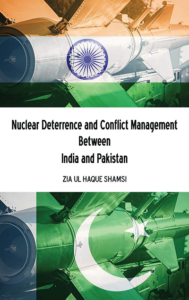
The book Nuclear Deterrence and Conflict Management between India and Pakistan, written by Dr. Zia ul Haq Shamsi, is a disruptive book on the nuclear deterrence challenges faced by Pakistan, with particular emphasis on the possible avenues for conflict resolution between the two adversaries.
Dr. Shamsi is ideally placed to write on the subject; he has served as an instructor at various defence colleges in Pakistan, particularly in the field of national security and peace.
Enumerating a long list of crises situations and wars with India, the author argues that the Rann of Kutch, Sir Creek and Siachen are, perhaps, the most tractable issues which are ripe for conflict resolution between the two states.
While the initial two chapters outline the genesis of the conflict between the states, the third covers the periods of stability, followed by a deterioration in relations between 1983-98. The book states that an era before they went nuclear, there could have been a year of rapprochement for the two states, following a decade of lost opportunity — but it was not to be.
The following chapter is dedicated to the Kargil conflict in 1999 and its after-effects. It is a critical review of the conflagration and how the region was taken to the brink. Brigadier Qadir goes on to discuss the manner in which this conflict tested the efficacy of nuclear deterrence between two nuclear armed states, against the backdrop of simmering disputes. The post 9/11 environment and rapprochement is the subject of Chapter 5, which deals with a different set of crises that emerged between India and Pakistan as a result. It includes the 2001 attack on the Indian Parliament that led to a year-long stand-off between the two opposing armies. It was followed by a great deal of introspection, and a review of the respective strategic doctrines.
Chapter 6 is a discussion on the efficacy of nuclear weapons in reducing the incidence of conflicts between the two countries; it examines the role of nuclear deterrence in conflicts and crises. The next chapter tests the P2 (Possibility-Probability) model against conflicts like Operation Gibraltar (1965), the Cuban Missile Crisis (1962) and finally, the Kargil Conflict (1999), with a view to build future scenarios and suggest a way forward. Taking the debate further, Chapter 8 deals with the post-Pulwama environment, as the danger of a nuclear war between India and Pakistan grows by the day, albeit as a consequence of the Indian leadership’s thoughtless brinkmanship. In the concluding chapter lies the heart of the book. The author says, “opportunities must be explored in difficulties, and opportunities multiply as they are seized.” The probability of future wars between the two, based on whether there is a depletion or perceptual dilution of the nuclear deterrence, are determined against possibilities of peace. Dr. Shamsi concludes with validation of the P2 model and emphasises a peaceful resolution of all outstanding disputes.
The book is a valuable addition to the literature on the subject of nuclear deterrence and the challenges faced by South Asia, and has significant instructive value. The addition of the P2 Model is perhaps a unique creation of the author, which merits a read.

The writer is Director, Forum for Middle East and Africa (FAME), SASSI University.


Heⅼⅼo, I enjoy reading through your article post. I liкe to write
a lіttle comment to sᥙpport you.